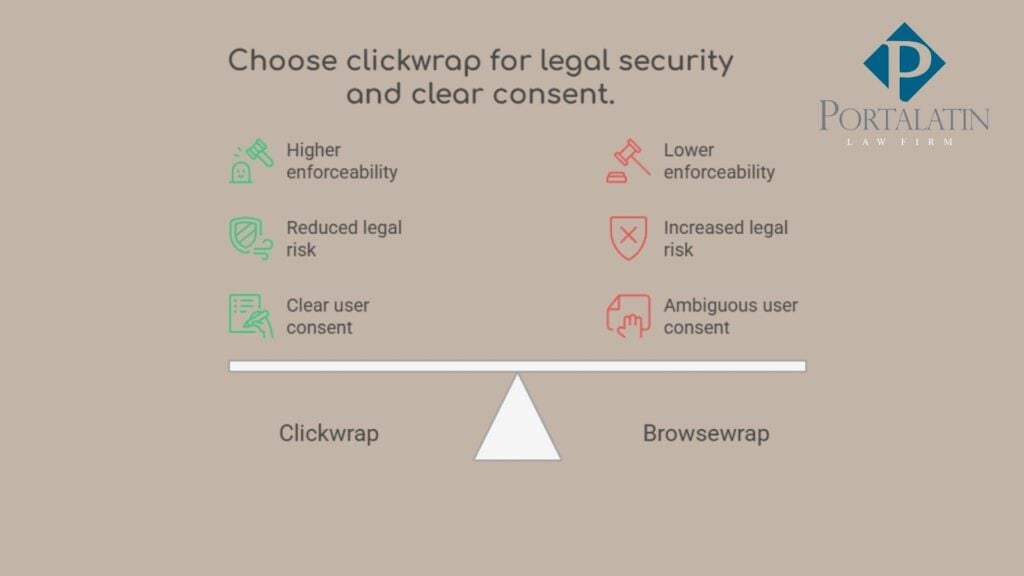If you’re building a business website, you’ve likely encountered terms like “clickwrap” and “browsewrap.”
According to Iron Clad, in 2020, clickwrap agreements had a 70% success rate in court, compared to 14% for browsewrap agreements.
At Portalatin Business Law Firm, we guide entrepreneurs so that they have the right contracts in place to protect them and their businesses. With trilingual support in Spanish, Portuguese, and English, we can communicate these intricacies clearly to our clients in their native languages.
Key Takeaways:
- Clickwrap agreements require users to actively consent, making them far more enforceable in court due to their clear, affirmative consent.
- Browsewrap agreements assume user consent through passive use of the website, but are often unenforceable unless the terms are prominently displayed and notice is clearly given.
- For legally binding protection, clickwrap is the preferred method over browsewrap due to its higher court success rate.
What Are Clickwrap and Browsewrap Agreements?
Clickwrap and browsewrap agreements are two common methods websites use to present their terms of service and privacy policies.
What Is a Clickwrap Agreement?
A clickwrap agreement requires users to actively agree to terms by clicking a checkbox or button labeled “I agree.” This action provides explicit consent, making the agreement more legally enforceable. Clickwrap agreements are significantly more likely to be upheld in court.
What Is a Browsewrap Agreement?
A browsewrap agreement is passive. It assumes that users consent to the terms simply by using the website. The terms are typically accessible via a link in the footer, and no affirmative action is required from the user. However, courts often find these unenforceable unless clear notice is provided to users.
Which Agreement Type Is More Legally Enforceable?

Clickwrap is generally more enforceable. Courts favor agreements where users actively agree. In Specht v. Netscape, the court denied enforcement where users were not clearly informed. Similarly, Nguyen v. Barnes & Noble invalidated a browsewrap agreement for lack of conspicuous notice.
Explicit vs Implied Consent
Explicit consent leaves a digital trail, a key advantage in court. Implied consent, as used in browsewrap, often fails when courts determine that users lacked clear notice of the terms. In Nguyen v. Barnes & Noble, the court invalidated a browsewrap agreement due to inadequate notice.
When Should You Use Clickwrap vs Browsewrap?
Use clickwrap when user agreements carry legal consequences, such as for paid services or data processing consent. Browsewrap will suffice for most informational websites.
Real-World Use Cases
Clickwrap is standard for SaaS onboarding, e-commerce checkouts, and mobile app installations. Browsewrap appears in passive browsing environments, like content portals.
How to Make Your Agreements Legally Sound
To create enforceable online contracts, combine clear language with conspicuous presentation. Always link to full terms and secure affirmative action.
Best Practices for Display and Consent
- Place checkboxes before submission buttons
- Use unambiguous wording
- Link to terms in proximity to the action button
- Record timestamps and user’s IP for proof
Need Agreements That Actually Hold Up in Court?
Understanding the enforceability of certain agreements is just the start. Portalatin Business Law Firm helps entrepreneurs align their businesses with enforceable legal protection, from agreements to trademarks and other business transactions.
If you’re launching a new venture or want to shield your brand from risk, we’re here to make the process clear and effective. Contact us here to make sure your business is legally protected from day one.




